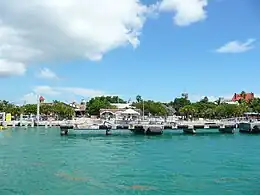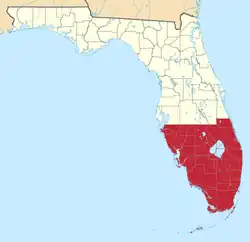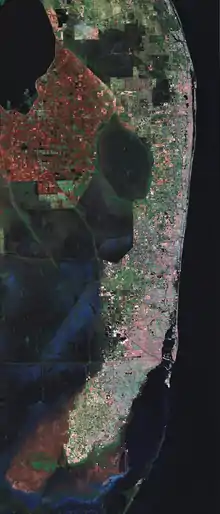South Florida
South Florida, sometimes colloquially shortened to SoFlo, is the southernmost region of the U.S. state of Florida. It is one of Florida's three most commonly referred to directional regions; the two others are Central Florida and North Florida. South Florida is the southernmost part of the continental United States and the only region of the continental U.S. that includes some areas with a tropical climate.
South Florida | |
|---|---|
      Clockwise from top: Downtown Miami seen from Biscayne Bay, South Beach in Miami Beach, Downtown Fort Lauderdale, Mallory Square in Key West, Freedom Tower in Miami, and Anhinga Trail in Everglades National Park | |
 | |
| Country | |
| State | |
| Largest city | |
| Population (2020) | 9,484,409[1] |
South Florida is dominated by the Miami metropolitan area and the Everglades, and contains the Florida Keys, three U.S. national parks, Biscayne, Dry Tortugas, and Everglades, and multiple cities. While the term most commonly refers to the Miami metro’s tri-county area, interpretations vary on the inclusion of some other parts of Florida within the South Florida region, such as the inclusion of Southwest Florida and the Treasure Coast.
Composition
As with all vernacular regions, South Florida has no official boundaries or status and is defined differently by different sources. A 2007 study of Florida's regions by Ary Lamme and Raymond K. Oldakowski found that Floridians surveyed identified "South Florida" as comprising the southernmost sections of peninsular Florida, meaning from Jupiter, Florida south. That area includes the Miami metropolitan area, defined as Miami-Dade, Broward, and Palm Beach counties, the Florida Keys, and the interior region known as the Glades.
Southwest Florida, representing the state's southern Gulf Coast, has emerged as a directional vernacular region. Respondents from as far northwest as the Tampa Bay area identified their region as being in Southwest or Central Florida.[2] Confusing the matter further, the University of South Florida, named in part because of its status as the state's southernmost public university at the time of its 1957 founding, is located in Tampa.[3] Florida State Road 70 bisects approximately the southern third of Florida from west to east.
Enterprise Florida, the state's economic development agency, identifies "Southeast Florida" as one of eight economic regions used by the agency and other state and outside entities, including the Florida Department of Transportation. Some entities alternately designate this region "South Florida".[4] Its definition includes much of the same territory as Lamme and Oldakowski's report, except the Gulf Coast and much of the interior Glades region.. It includes Monroe County and the three metropolitan counties of Miami-Dade, Broward, and Palm Beach, as well as the three "Treasure Coast" counties of Indian River, St. Lucie, and Martin to the north.[5]
Demographics
The demographics of South Florida residents can be segmented as following:
| Population % | Place of Birth |
|---|---|
| 32.2% | State of Florida |
| 33.0% | Elsewhere in the U.S. |
| 34.8% | Outside of the U.S. |
Over 87.2% of all foreigners residing in South Florida come from Latin America.
Political affiliations
South Florida is politically diverse, with multiple congressional districts in the region supporting both the Democratic and Republican parties. As evidenced by the 2020 United States presidential election, supporters of the Democratic Party are mostly concentrated in urban areas, as well as areas to the west of and including downtown Key West, rural communities surrounding Immokalee, and the areas surrounding Belle Glade, while supporters of the Republican Party reside in the most costal regions of the Miami area north of Pompano Beach, most of the Everglades, most of the regions between Port St. Lucie and Riviera Beach, Southwest Florida, and a supermajority of the region's inland and rural areas.[6]
Cities

Largest cities in South Florida by population:
| City | 2020 population[7] | 2010 population[8] | 2000 population | County |
|---|---|---|---|---|
| Miami | 442,241 | 399,457 | 362,470 | Miami-Dade |
| Hialeah | 223,109 | 224,669 | 226,419 | Miami-Dade |
| Fort Lauderdale | 182,760 | 165,521 | 152,397 | Broward |
| Pembroke Pines | 171,178 | 154,750 | 137,427 | Broward |
| Hollywood | 153,067 | 140,768 | 139,368 | Broward |
| Miramar | 134,721 | 122,041 | 72,739 | Broward |
| Coral Springs | 134,394 | 121,096 | 117,549 | Broward |
| Miami Gardens | 111,640 | 107,167 | 124,656 | Miami-Dade |
| West Palm Beach | 117,415 | 99,919 | 82,103 | Palm Beach |
| Pompano Beach | 112,046 | 99,845 | 78,191 | Broward |
| Davie | 105,691 | 91,992 | 75,720 | Broward |
| Miami Beach | 82,890 | 87,779 | 87,933 | Miami-Dade |
| Plantation | 91,750 | 84,955 | 82,934 | Broward |
| Sunrise | 97,335 | 84,439 | 85,787 | Broward |
| Boca Raton | 97,422 | 84,392 | 74,764 | Palm Beach |
| Deerfield Beach | 86,859 | 75,018 | 64,585 | Broward |
| Boynton Beach | 80,380 | 68,217 | 60,389 | Palm Beach |
| Lauderhill | 74,482 | 66,887 | 57,585 | Broward |
| Weston | 68,107 | 65,333 | 49,286 | Broward |
| Delray Beach | 66,846 | 60,522 | 60,020 | Palm Beach |
| Homestead | 80,737 | 60,512 | 31,909 | Miami-Dade |
| Tamarac | 71,897 | 60,427 | 55,588 | Broward |
| North Miami | 60,191 | 58,786 | 59,880 | Miami-Dade |
| Wellington | 61,637 | 56,508 | 38,216 | Palm Beach |
| Jupiter | 61,047 | 55,156 | 39,328 | Palm Beach |
| Margate | 58,712 | 53,284 | 53,909 | Broward |
| Coconut Creek | 57,833 | 52,909 | 43,566 | Broward |
Culture
Miami accent
The Miami accent is a regional accent of the American English dialect spoken in South Florida, particularly in Miami-Dade, Broward, Palm Beach, and Monroe counties. The accent was born in central Miami, but has expanded to the rest of South Florida in the decades since the 1960s. The Miami accent is most prevalent in American-born South Floridian youth.[9][10][11]
The Miami accent is based on a fairly standard American accent but with some changes very similar to dialects in the Mid-Atlantic (especially the New York area dialect, Northern New Jersey English, and New York Latino English.) Unlike Virginia Piedmont, Coastal Southern American, and Northeast American dialects, the "Miami accent" is rhotic; it also incorporates a rhythm and pronunciation heavily influenced by Spanish (wherein rhythm is syllable-timed).[12]
Politics

Lamme and Oldakowski identify several demographic, political, and cultural elements that characterize South Florida and distinguish it from other areas of the state. Many of its differences appear to be driven by its proportionately higher level of migration from the northern U.S. states and from the Caribbean and Latin America, particularly in the densely populated Miami area.[13] Politically, South Florida is more liberal than the rest of the state. While less than 10% of people in either North or Central Florida felt their area was liberal, over a third of South Floridians described their region as such.[14] 38% characterized the area as conservative; 26% as moderate.[14] This tracks with South Florida's demographics, and Lamme and Oldakowski's findings parallel Barney Warf and Cynthia Waddell's research on Florida's political geography during the 2000 Presidential election.[14][15] The economy in South Florida is very similar to that in Central Florida. Compared to the more diversified economy in North Florida, tourism is by far the most significant industry in South and Central Florida, with a much smaller but vibrant agricultural industry.[16]
Cuisine
Lamme and Oldakowski's survey also found some cultural indicators distinguishing South Florida. South Florida is the only region of the state where ethnic foods are as popular as general American cuisine.[17] Floribbean cuisine is a fusion cuisine which developed in South Florida, drawing influence from Floridian, Caribbean, Asian and Latin American cuisines. Additionally, while there was little geographical variation for most styles of music, there was regional variation for both country and Latin music. Country was significantly less popular in South Florida than in North or Central Florida, while Latin was more popular than in the other regions.[17]
Urban planning
The Anthony J. Catanese Center for Urban and Environmental Solutions at Florida Atlantic University notes the unusual growth pattern of South Florida. Unlike many areas with centralized cities surrounded by development, most of South Florida is preserved natural area and designated agricultural reserves, with development restricted to a dense, narrow strip along the coast. The developed area is highly urbanized and increasingly continuous and decentralized, with no particular dominant core cities. The center projects this pattern to continue in the future.[18]
Partition proposals

There have been several proposals for partitioning the state of Florida to form a separate state of South Florida. Such proposals have usually been made as political statement rather than serious attempts at secession. Reasons often stated are cultural, ethnic, economic, and financial frustrations with the state government in Tallahassee, which is in North Florida.[19]
In 2008, the North Lauderdale City Commission passed a resolution calling for a new state of South Florida to be formed from Palm Beach, Broward, Miami-Dade and Monroe Counties.[20][19]
In 2014, South Miami's city commission passed a resolution in favor of splitting the state in half, with a northern boundary drawn to include the counties of Brevard, Orange, Polk, Hillsborough, and Pinellas, which roughly includes the Tampa Bay and Orlando areas. In total, the proposed State of South Florida would have included 24 counties.[21][22][23]
Notes
- "County Population". www.census.gov.
- Lamme & Oldakowsi, p. 329.
- "USF History". usf.edu. University of South Florida. Retrieved April 23, 2020.
- "Charting the Course" uses "the term 'Southeast' Florida interchangeably with 'South' Florida" for this region; p. 3.
- "Charting the Course", p. 2–3.
- Park, Alice; Smart, Charlie; Taylor, Rumsey; Watkins, Miles (2021-02-02). "An Extremely Detailed Map of the 2020 Election". The New York Times. ISSN 0362-4331. Retrieved 2022-10-25.
- Bureau of Economic and Business Research (2011). "Florida Population: Census Summary 2010". University of Florida.
{{cite web}}:|author=has generic name (help) - Bureau of Economic and Business Research (2021). "Florida Population: Census Summary 2020". University of Florida. Archived from the original on 2020-09-27. Retrieved 2017-04-18.
{{cite web}}:|author=has generic name (help) - Haggin, Patience (27 August 2013). "Miami Accents: Why Locals Embrace That Heavy "L" Or Not". Wlrn.org. Retrieved 10 July 2018.
- Watts, Gabriella (26 August 2013). "Miami Accents: How 'Miamah' Turned Into A Different Sort Of Twang". Wlrn.org. Retrieved 10 July 2018.
- "English in the 305 has its own distinct Miami sound - Lifestyle - MiamiHerald.com". Miamiherald.com. Retrieved 10 July 2018.
- "'Miami Accent' Takes Speakers By Surprise". Articles – Sun-Sentinel.com. June 13, 2004. Archived from the original on 2012-08-20. Retrieved 2012-10-08.
- Lamme & Oldakowsi, p. 330.
- Lamme & Oldakowsi, p. 336.
- Warf & Waddell, pp. 88.
- Lamme & Oldakowsi, pp. 336–337.
- Lamme & Oldakowsi, p. 337.
- "Charting the Course", p. 3.
- Morelli, Keith (May 8, 2008). "2 Broward Cities Plant Seeds of Secession". The Tampa Tribune. Archived from the original on September 8, 2017. Retrieved November 23, 2016.
- Huriash, Lisa J. (May 6, 2008). "North Lauderdale wants to split Florida into two states". Sun-Sentinel.
- Cutway, Adrienne. "Officials want South Florida to break off into its own state". Sun-sentinel.com. Retrieved 10 July 2018.
- Cutway, Adrienne. "Officials want South Florida to break off into its own state". Orlandosentinel.com. Retrieved 10 July 2018.
- "Officials want to create 51st state in South Florida". Archived from the original on 2014-10-22. Retrieved 2014-10-22.
References
- Lamme, Ary J.; Oldakowski, Raymond K. (November 2007). "Spinning a New Geography of Vernacular Regional Identity: Florida in the Twenty-First Century". Southeastern Geographer. 47 (2): 320–340. doi:10.1353/sgo.2007.0029. S2CID 129577530.
- Warf, Barney; Waddell, Cynthia (January 2002). "Florida in the 2000 Presidential Election: Historical Precedents and Contemporary Landscapes". Political Geography. 21 (1): 85–90. doi:10.1016/S0962-6298(01)00063-4.
- Anthony J. Catanese Center for Urban and Environmental Solutions at Florida Atlantic University (2006). "Charting the Course: Where is South Florida Heading?" (PDF). Florida Atlantic University. Archived from the original (PDF) on December 16, 2011. Retrieved March 23, 2012.
{{cite journal}}: Cite journal requires|journal=(help)
